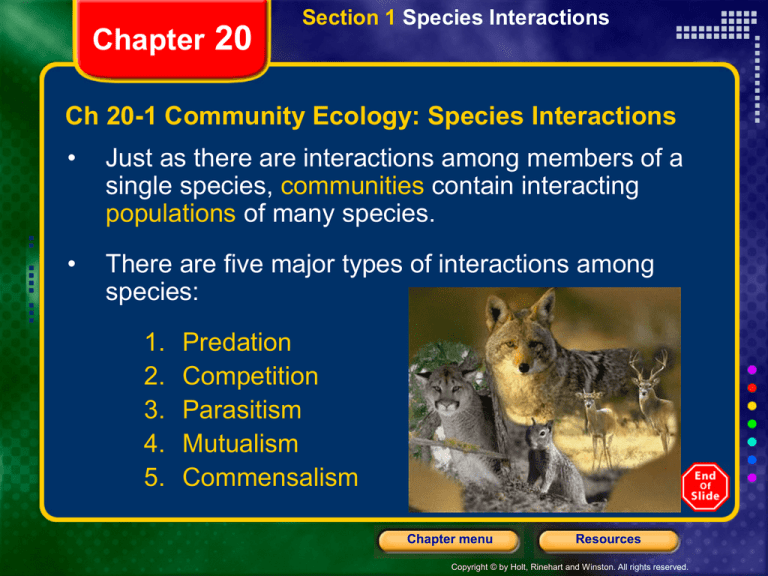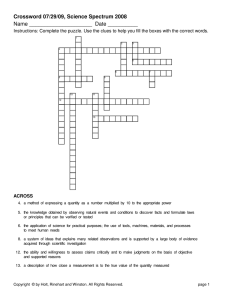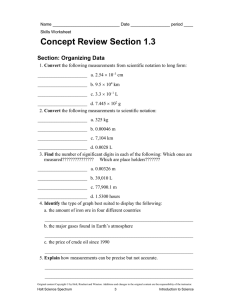
Chapter 20
Section 1 Species Interactions
Ch 20-1 Community Ecology: Species Interactions
•
Just as there are interactions among members of a
single species, communities contain interacting
populations of many species.
•
There are five major types of interactions among
species:
1.
2.
3.
4.
5.
Predation
Competition
Parasitism
Mutualism
Commensalism
Chapter menu
Resources
Copyright © by Holt, Rinehart and Winston. All rights reserved.
Chapter 20
Section 1 Species Interactions
• Predation is an
interaction in which one
organism (the predator)
captures and eats all or
part of another
individual organism (the
prey).
– Both predator and prey
continue to evolve in the
never ending battle to
survive. “Survival of the
Fittest”
Chapter menu
Resources
Copyright © by Holt, Rinehart and Winston. All rights reserved.
Chapter 20
Section 1 Species Interactions
Predation
Click below to watch the Visual Concept.
Visual Concept
Chapter menu
Resources
Copyright © by Holt, Rinehart and Winston. All rights reserved.
• Competition occurs when
two or more organisms, of
the same or different species,
use the same limited
resource.
– The species that is best
adapted to use the
resource or prevent its
competition from using the
resource will survive.
Chapter menu
Resources
Copyright © by Holt, Rinehart and Winston. All rights reserved.
Chapter 20
Section 1 Species Interactions
Symbiosis
• Symbiosis is a close, long-term relationship between
two organisms. There are three types of symbiosis.
– Parasitism
– Mutualism
– Commensalism
Chapter menu
Resources
Copyright © by Holt, Rinehart and Winston. All rights reserved.
Chapter 20
Section 1 Species Interactions
• Parasitism
– In parasitism, one species (the parasite) feeds on,
but does not always kill, another
species (the host).
• Lice, leaches, fleas, ticks, and
mosquitoes are ectoparasites
and live outside of their host.
• Heartworm, disease causing protists,
and tapeworms are endoparasites
and live inside of their host.
Chapter menu
Resources
Copyright © by Holt, Rinehart and Winston. All rights reserved.
Chapter 20
Section 1 Species Interactions
• Mutualism
– In mutualism, both interacting species
benefit.
• Pollination is one of the most important
mutualistic relationships on Earth.
– As the pollinators; bees, butterflies,
beetles, bats, and birds eat the nectar
found in the flower, they inadvertently
carry pollen between flowers.
– The flowering plants get pollinated and
the pollinator gets food.
Chapter menu
Resources
Copyright © by Holt, Rinehart and Winston. All rights reserved.
Chapter 20
Section 1 Species Interactions
• Commensalism
– In commensalism, one
species benefits, and the other
is not affected.
– The egret bird has a
relationship with grazing
animals. The egret benefits by
eating the insects and lizards
that are stirred up as the
animals graze.
– The grazing animals are not
benefited or harmed by the
egrets.
Symbiosis Practice
Chapter menu
Resources
Copyright © by Holt, Rinehart and Winston. All rights reserved.
Chapter 20
Section 2 Patterns in Communities
20-2 Community Stability and Species Richness
• One of the most important characteristics of a community is
how it responds to disturbance.
– Disturbances are events that change communities such as
• removing organisms
• abiotic disturbances such as fire, flood, volcanic
eruption, bulldozing, paving
• introducing new organisms
– Species richness or diversity may improve a community’s
stability by having more links between its organisms. The
links will spread out the effects of the disturbance.
– Areas of low species richness may be less stable in the
event of an ecological disturbance.
Chapter menu
Resources
Copyright © by Holt, Rinehart and Winston. All rights reserved.
Chapter 20
Section 2 Patterns in Communities
Successional Changes in Communities
• Ecological succession is the gradual, sequential
growth or regrowth of a community of species in an
area over time.
• Ecologists recognize two types of succession:
– Primary Succession, and
– Secondary Succession
Chapter menu
Resources
Copyright © by Holt, Rinehart and Winston. All rights reserved.
Chapter 20
Section 2 Patterns in Communities
• Primary succession is the development of a
community in an area that has not supported life
previously, such as bare rock, a sand dune, or an
island formed by a volcanic eruption.
– Soil is not initially present in areas undergoing
primary succession.
Chapter menu
Resources
Copyright © by Holt, Rinehart and Winston. All rights reserved.
Chapter 20
Section 2 Patterns in Communities
Pioneer Species
• Pioneer species are the
species of organisms that
tend to be the first to appear
in early succession. Pioneer
species tend to be small, well
suited to bare environment,
grow and reproduce quickly.
• Slow succession!
Visual Concept
Chapter menu
Resources
Copyright © by Holt, Rinehart and Winston. All rights reserved.
Chapter 20
Section 2 Patterns in Communities
Secondary Succession
• Secondary succession is the change in an existing
community following a disturbance.
• Secondary succession occurs in areas where the
original ecosystem has been cleared by a disturbance
but, the soil layer remains.
– These disturbances may
be natural; fire, volcanic
eruption, or manmade;
logging, mining, or
bulldozing.
Chapter menu
Resources
Copyright © by Holt, Rinehart and Winston. All rights reserved.
Climax Community
• The community proceeds
through a predictable series of
stages until it reaches a stable
end point.
– The organisms in each
stage alter the physical
environment in ways that
make it less favorable for
their own survival but more
favorable for the organisms
that eventually succeed
them.
Chapter menu
Resources
Copyright © by Holt, Rinehart and Winston. All rights reserved.
• 22 min video shows blast and also the return of plants.
• 1:20 min satellite views of 30 years following the eruption.
Mount St. Helens and Succession
Chapter menu
Resources
Copyright © by Holt, Rinehart and Winston. All rights reserved.
In the Beginning
MHS 1993
Chapter menu
Resources
Copyright © by Holt, Rinehart and Winston. All rights reserved.
There Was Dirt
Chapter menu
Resources
Copyright © by Holt, Rinehart and Winston. All rights reserved.
Lots and Lots
Chapter menu
Resources
Copyright © by Holt, Rinehart and Winston. All rights reserved.
Of Dirt
Chapter menu
Resources
Copyright © by Holt, Rinehart and Winston. All rights reserved.
Chapter menu
Resources
Copyright © by Holt, Rinehart and Winston. All rights reserved.
Chapter menu
Resources
Copyright © by Holt, Rinehart and Winston. All rights reserved.
Chapter menu
Resources
Copyright © by Holt, Rinehart and Winston. All rights reserved.
Chapter menu
Resources
Copyright © by Holt, Rinehart and Winston. All rights reserved.
Chapter menu
Resources
Copyright © by Holt, Rinehart and Winston. All rights reserved.
Chapter menu
Resources
Copyright © by Holt, Rinehart and Winston. All rights reserved.
Chapter menu
Resources
Copyright © by Holt, Rinehart and Winston. All rights reserved.
Chapter menu
Resources
Copyright © by Holt, Rinehart and Winston. All rights reserved.
Chapter menu
Resources
Copyright © by Holt, Rinehart and Winston. All rights reserved.
Chapter menu
Resources
Copyright © by Holt, Rinehart and Winston. All rights reserved.
Chapter menu
Resources
Copyright © by Holt, Rinehart and Winston. All rights reserved.





